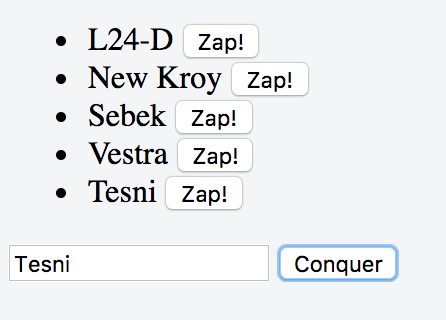If you followed the first recipe in this chapter, you'll remember how we greeted a variable number of worlds; we can make the experience more interactive. Let's build a list of planets we'd like to greet:
<div id="app">
<ul>
<li v-for="world in worlds">{{world}}</li>
</ul>
</div>
new Vue({
el: '#app',
data: {
worlds: ['Terran', 'L24-D', 'Ares', 'New Kroy', 'Sebek', 'Vestra']
}
})
We want to be able to keep track of newly conquered worlds and delete the ones we destroy. This means adding and removing elements from the list. Consider the following HTML:
<ul>
<li v-for="(world, i) in worlds">
{{world}}
<button @click="worlds.splice(i, 1)">Zap!</button>
</li>
</ul>
<input v-model="newWorld"/>
<button @click="worlds.push(newWorld)">Conquer</button>
Here the @ symbol is the shorthand for v-on: Let's examine the modifications:
- We added a button to remove the planet (we needed to write out the index in the v-for)
- We placed a textbox that is bound to the data variable newWorld
- We placed a corresponding button that adds what's inside the textbox to the list
Running this code will work. But if you look at the console, you will see a warning when you update the text field:
[Vue warn]: Property or method "newWorld" is not defined on the instance but referenced during render. Make sure to declare reactive data properties in the data option. (found in root instance)
This is because we never declared newWorld in our Vue instance, but that's easy to fix:
new Vue({
el: '#app',
data: {
worlds: ['Terran', 'L24-D', 'Ares', 'New Kroy', 'Sebek', 'Vestra'],
newWorld: ''
}
})



 Free Chapter
Free Chapter

